247 scholarly books by University Press of New England and 16
start with T
247 scholarly books by University Press of New England and 16
247 scholarly books by University Press of New England
16 start with T start with T
16 start with T start with T

Tell
Love, Defiance, and the Military Trial at the Tipping Point for Gay Rights
Major Margaret Witt
University Press of New England, 2017
In 1993 Margie Witt, a young Air Force nurse, was chosen as the face of the Air Force’s “Cross into the Blue” recruitment campaign. This was also the year that President Clinton’s plan for gays to serve openly in the military was quashed by an obdurate Congress, resulting in the blandly cynical political compromise known as Don’t Ask, Don’t Tell. Contrary to its intent, DADT had the perverse effect of making it harder for gay servicemen and -women to fight expulsion. Over the next seventeen years more than 13,000 gay soldiers, sailors, marines, coast guard, and airmen and -women were removed from military service. That is, until Margie Witt’s landmark case put a stop to it. Tell is the riveting story of Major Margaret Witt’s dedicated and decorated military career as a frontline flight nurse, and of her love and devotion to her partner—now wife—Laurie Johnson. Tell captures the tension and drama of the politically charged legal battle that led to the congressional repeal of the controversial law and helped pave the way for a suite of landmark political and legal victories for gay rights. Tell is a testament to the power of love to transform hearts and minds, as well as a celebration of the indomitable spirit of Major Witt, her wife Laurie, her dedicated legal team, and the brave men and women who came forward to testify on her behalf in a historic federal trial. “The name Margaret Witt may join the canon of US civil rights pioneers.” —Guardian “Major Witt’s trial provided an unparalleled opportunity to attack the central premise of [Don’t Ask, Don’t Tell] . . . and set an important precedent.”— New York Times “A landmark ruling.”—Politico
[more]

That’s Gotta Hurt
The Injuries That Changed Sports Forever
Dr. David Geier
University Press of New England, 2017
In That’s Gotta Hurt, the orthopaedist David Geier shows how sports medicine has had a greater impact on the sports we watch and play than any technique or concept in coaching or training. Injuries among professional and college athletes have forced orthopaedic surgeons and other healthcare providers to develop new surgeries, treatments, rehabilitation techniques, and prevention strategies. In response to these injuries, sports themselves have radically changed their rules, mandated new equipment, and adopted new procedures to protect their players. Parents now openly question the safety of these sports for their children and look for ways to prevent the injuries they see among the pros. The influence that sports medicine has had in effecting those changes and improving both the performance and the health of the athletes has been remarkable. Through the stories of a dozen athletes whose injuries and recovery advanced the field (including Joan Benoit, Michael Jordan, Brandi Chastain, and Tommy John), Dr. Geier explains how sports medicine makes sports safer for the pros, amateurs, student-athletes, and weekend warriors alike. That’s Gotta Hurt is a fascinating and important book for all athletes, coaches, and sports fans.
[more]
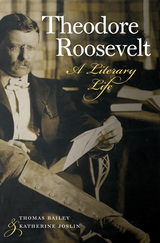
Theodore Roosevelt
A Literary Life
Thomas Bailey and Katherine Joslin
University Press of New England, 2018
Of all the many biographies of Theodore Roosevelt, none has presented the twenty-sixth president as he saw himself: as a man of letters. This fascinating account traces Roosevelt’s lifelong engagement with books and discusses his writings from childhood journals to his final editorial, finished just hours before his death. His most famous book, The Rough Riders—part memoir, part war adventure—barely begins to suggest the dynamism of his literary output. Roosevelt read widely and deeply, and worked tirelessly on his writing. Along with speeches, essays, reviews, and letters, he wrote history, autobiography, and tales of exploration and discovery. In this thoroughly original biography, Roosevelt is revealed at his most vulnerable—and his most human.
[more]
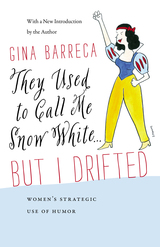
They Used to Call Me Snow White . . . But I Drifted
Women’s Strategic Use of Humor
Gina Barreca
University Press of New England, 2013
Published by Viking in 1991 and issued as a paperback through Penguin Books in 1992, Snow White became an instant classic for both academic and general audiences interested in how women use humor and what others (men) think about funny women. Barreca, who draws on the work of scholars, writers, and comedians to illuminate a sharp critique of the gender-specific aspects of humor, provides laughs and provokes arguments as she shows how humor helps women break rules and occupy center stage. Barreca’s new introduction provides a funny and fierce, up-to-the-minute account of the fate of women’s humor over the past twenty years, mapping what has changed in our culture—and questioning what hasn’t.
[more]
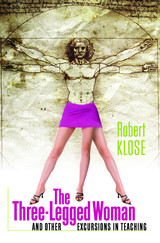
The Three-Legged Woman and Other Excursions in Teaching
Robert Klose
University Press of New England, 2013
Since 1986, Robert Klose has taught biology at a “small, impoverished, careworn” college in central Maine. Located on a former military base, the school became first the South Campus of the University of Maine, or SCUM, and later, Penobscot Valley Community College, then Bangor Community College, and most recently University College of Bangor. Despite its improved nomenclature, University College of Bangor remains an open-admissions environment at which “one never knows what’s going to come in over the transom.” Klose’s nontraditional students have included, in addition to single parents and veterans, the homeless, the abused, ex-cons, and even a murderer (who was otherwise “a very nice person”). Chronicling his experiences teaching these diverse students, Klose describes with equal doses of care and wry wit those who are profoundly unfit for college, their often inadequate command of the lingua franca, and the alacrity with which they seize upon the paranormal (the three-legged woman) while expressing skepticism about mainstream science. He reflects on the decline of reading for enjoyment and the folly of regarding email as a praiseworthy substitute for expository writing. He details what works in the classroom, identifies what has failed, and relates stories of the absurd, the sublime, and the unanticipated, such as one student’s outburst following a discussion of evolution: “For what you have taught today you shall be damned to everlasting fires of hell!” Tempering thoughtfulness with a light touch and plenty of humor, these essays prove that teaching, an “imperfect occupation,” remains a “special profession.”
[more]

Through a Naturalist's Eyes
Exploring the Nature of New England
Michael J. Caduto
University Press of New England, 2016
For native and visitor alike, the New England landscape has a rich allure. This grand sweep of land is a living tapestry woven of interconnected bioregions and natural communities whose compositions of plants and animals have evolved over time. In more than fifty essays, Michael J. Caduto brings readers into the complex stories to be found in nature. Drawing on first-hand experiences and reflections on the relationship between the natural world and humans, Caduto explores some of the plants, animals, natural places, and environmental issues of New England—from dragonflies, cuckoos, and chipmunks to circumpolar constellations and climate change. Stunning illustrations by Adelaide Murphy Tyrol illuminate these elegant and humorous essays.
[more]

Tiber
Eternal River of Rome
Bruce Ware Allen
University Press of New England, 2018
In this rich history of Italy’s Tiber River, Bruce Ware Allen charts the main currents, mythic headwaters, and hidden tributaries of one of the world’s most renowned waterways. He considers life along the river, from its twin springs high in the Apennines all the way to its mouth at Ostia, and describes the people who lived along its banks and how they made the Tiber work for them. The Tiber has served as the realm of protomythic creatures and gods, a battleground for armies and navies, a livelihood for boatmen and fishermen, the subject matter of poets and painters, and the final resting place for criminals and martyrs. Tiber: Eternal River of Rome is a highly readable history and a go-to resource for information about Italy’s most storied river.
[more]
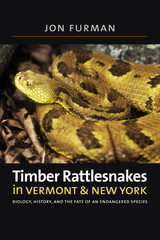
Timber Rattlesnakes in Vermont & New York
Biology, History, and the Fate of an Endangered Species
Jon Furman
University Press of New England, 2007
Today, small populations of timber rattlesnakes (Crotalus horridus) quietly inhabit parts of Rutland County in Vermont, and Warren, Washington, and Essex counties in New York. Because the species is endangered, the exact locations of established dens in this area are a closely guarded secret. Insider, naturalist, and author Jon Furman has devoted years to the study of the snake’s past and present range, its habitat and biology, the period in Vermont and upstate New York history during which timber rattlesnakes were ruthlessly hunted for a bounty, and the outlook for this severely threatened species in both states. Soundly anchored in the latest scientific data, Furman proffers an accessible and engaging account of contemporary fieldwork and first-person interviews with herpetologists and old-time bounty hunters. For expert and lay readers interested in snakes and reptiles, northeastern fauna and natural history, conservation, and endangered species, this volume clearly explicates the timber rattlesnake’s biology as well as what happens and what to do when one bites. It also explores the troubling decline of the northeastern population caused by bounty hunting between the 1890s and the early 1970s, other past and present threats to the species’ survival, and what measures are being taken—and additional ones that must be taken—to ensure that timber rattlesnakes survive and thrive in the northeast. Historical and contemporary illustrations bring these reptiles and their world to life. Timber Rattlesnakes in Vermont & New York shines a new light on a maligned and misunderstood species.
[more]
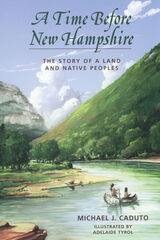
A Time Before New Hampshire
The Story of a Land and Native Peoples
Michael J. Caduto
University Press of New England, 2004
In this masterful and elegant book, Michael J. Caduto tells the complete story of the land of New Hampshire—starting with the formation of earth 4.6 billion years ago and continuing with changes to its peoples and the environment through the seventeenth century. Part I offers a comprehensive look at every aspect of the ancient natural world—including geology, glaciology, botany, climatology, ecology, zoology, and paleobotany. It describes the formation of the land hundreds of millions of years ago as a result of major movements in the tectonic plates; chronicles the rise and fall of reptiles, mammals, birds, and plants and other life forms stemming from climatic changes; and explores the arrival of human beings during and after the relatively recent ice age. The rest of the volume immerses the reader in the history of the human populations in New Hampshire, beginning with the Paleoindian period of hunter gatherers over twelve thousand years ago and continuing through the arrival of horticulture among the Alnôbak (Abenaki) and beyond. Caduto explores the Alnôbak’s day-to-day existence, culture, and traditional tales as preserved by archeologists, anthropologists, historians, and living cultures. Emphasizing the beliefs, cultures, and practices of these native people, Caduto details the Alnôbak’s relationship to the natural world as he tells the story of coevolution between the land and people through time. Caduto takes the reader on an exploration through New Hampshire’s rich and diverse history—using first-hand experiences, re-creations of natural and human environments, journeys through historical landscapes and visits with the families of ancient people—to present a thorough profile of the early beginnings of the Granite State. The volume features an epilogue by Charlie True, Member of the Tribal Council, Abenaki Nation of New Hampshire, and nearly one hundred photographs, illustrations, and detailed maps depicting past peoples, historical trails, and indigenous cultures and environments of New Hampshire.
[more]

Tommy Gun Winter
Jewish Gangsters, a Preacher's Daughter, and the Trial That Shocked 1930s Boston
Nathan Gorenstein
University Press of New England, 2015
This is the true tale of two brothers, sons of a successful Jewish contractor, who along with an MIT graduate and a minister’s daughter once competed for headlines with John Dillinger, Pretty Boy Floyd and Bonnie and Clyde. The gang was led by the angry, violent, yet often charismatic Murton Millen, a small-time hoodlum and aspiring race-car driver. With his younger brother, Irv, and later joined by neighborhood buddy and MIT graduate Abe Faber, Murt launched a career of increasingly ambitious robberies. But it was only after his sudden marriage to the beautiful eighteen-year-old Norma Brighton that the gang escalated to murder. Their crime wave climaxed at a Needham, Massachusetts, bank on February 2, 1934, when Murt cut down two local police officers—Francis Haddock and Forbes McLeod—with a Thompson submachine gun stolen from state police. The killings, the dogged investigation by two clever detectives, and the record-setting trial with seventeen psychiatrists were national news. In Depression-era America this Boston saga of sex, ethnicity, and bloodshed made the trio and their “red-headed gun moll” infamous. Gorenstein’s account explores the Millen, Faber, and Brighton families and introduces us to cops, psychiatrists, newspaper men and women, and ordinary citizens caught up in the extraordinary Tommy Gun Winter of 1934.
[more]
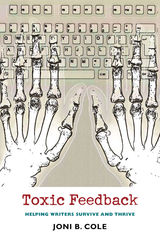
Toxic Feedback
Helping Writers Survive and Thrive
Joni Cole
University Press of New England, 2006
All writers have stories of how some teacher, workshop participant, friend, or spouse gave them commentary that undermined their confidence and their writing. This “toxic feedback” has tainted feedback's reputation as a whole, causing too many writers to avoid or mismanage this valuable resource. In the first book to focus on this vital but delicate dynamic, Joni B. Cole applies first-person experience, real-life teaching examples, and her own unique ability to entertain while reaffirming the many merits of feedback. Cole shows writers how to use feedback to energize and inform their writing at every stage of the process. For feedback providers, she delivers insights into constructive criticism and the difference between being heard and being obnoxious. Finally, she offers advice to workshops and critique groups on how to thrive in this collective experience. In addition, established writers ranging from Julia Alvarez and Khaled Hosseini to Gregory Maguire and Jodi Picoult share their own feedback stories -- from useful to inspiring to deranged -- underscoring Cole's message that feedback plays a critical role in every writer's success. Through a mixture of instruction, anecdotes, and moral support, Cole manages to detoxify the feedback process with humor and without laying blame, inspiring both sides of the interaction to make the most of this powerful resource.
[more]
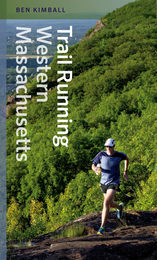
Trail Running Western Massachusetts
Ben Kimball
University Press of New England, 2015
Ben Kimball, a long-time trail runner, provides profiles of fifty-one great trail runs in western Massachusetts. Geographically, this book covers the area between the Quabbin Reservoir and upstate New York, including the Pioneer Valley and Berkshire areas as well as portions of the Taconic Highlands. Elevations range from the lowlands of the Connecticut River and Housatonic River valleys to the state’s highest point at the top of Mount Greylock. The trails profiled represent a range of locations within the region as well as a range of difficulty levels and terrain types. There are options for everyone, from the beginner to the experienced trail runner looking for new options. Each run receives a two-page treatment that includes an informative trail description and a trail map, along with a scannable QR code to download each map to your smartphone. This book will appeal to the entire running community of Massachusetts and the surrounding region, including the Pioneer Valley along the Connecticut River, communities along the Housatonic River corridor in the Berkshires, the many running clubs in the Boston area, and seasonal vacationers.
[more]

Transgender Voices
Beyond Women and Men
Lori B. Girshick
University Press of New England, 2009
In this extraordinary book, based on 150 in-depth interviews, Lori B. Girshick, a sociologist and social justice activist, brings together the voices of sex- and gender-diverse people who speak with absolute candor about their lives. Girshick presents transpeople speaking in their own voices about identity, coming out, passing, sexual orientation, relationship negotiations and the dynamics of attraction, homophobia (including internalized fears), and bullying. She exposes the guilt and the shame that “gender police” use in their attempts to exert control and points out the many ways transpeople are discriminated against in daily life, from filling out identification documents to gender-segregated bathrooms. By showing us a variety of descriptions of diverse real lives and providing a thorough exploration of the embodied experiences of gender variant people, Girshick demonstrates that there is nothing inherently binary about gender, and that the way each of us experiences our own gender is, in fact, normal and natural.
[more]
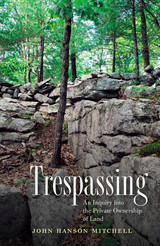
Trespassing
An Inquiry into the Private Ownership of Land
John Hanson Mitchell
University Press of New England, 2015
Trespassing, “a thoughtful, beautifully written addition to environmental and regional literature” (Kirkus Reviews), is a historical survey of the evolution of private ownership of land, concentrating on the various land uses of a 500-acre tract of land over a 350-year period. What began as wild land controlled periodically by various Native American tribes became British crown land after 1654, then private property under US law, and finally common land again in the late twentieth century. Mitchell considers every aspect of the important issue of land ownership and explores how our attitudes toward land have changed over the centuries.
[more]
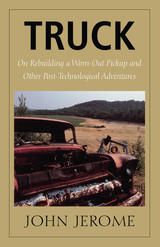
Truck
On Rebuilding a Worn-Out Pickup and Other Post-Technological Adventures
John Jerome
University Press of New England, 1996
“Know thy gadgets; first step in restoring some kind of wholeness to one’s life.” So observes John Jerome about his purpose for rebuilding a 1950 Dodge pickup. Yes, he needs the truck to haul manure, but Jerome also hopes that “by knowing every nut, lockwasher, and cotter pin I could have a machine that had some meaning to me.” Thus his year-long odyssey under the hood, among the brake shoes and valves, becomes more than a mechanic’s memoir; it is a meditation on machines, metaphysics, and the moral universe. Long after its publication in 1977, the essential dilemma of Truck still rings true: as Jerome dismantles the aged straight six, he also disassembles our reliance on “two-hundred-dollar appliances that sport flaws in thirty-five-cent parts” and decries the “deliberate encapsulation, impenetrability, of the overtechnologized things with which we furnish our lives.” Despite gouged knuckles, a frigid New Hampshire winter, frustrating and inexplicable assemblies, and a close call when the truck rolls off its jacks, he perseveres. In the end, he admits, “I did not find God out there in the barn among the cans of nuts and bolts.” What he does find, however, is that he must make peace with technology; it’s a mistake, he says, to “assume there is a point on that line between the caveman’s club and the moon shot that marks the moral turnaround, before which technology was somehow benign, after which it is malign.” While Jerome gains a truck that runs—sometimes—we gain new insight into a technology that continues to encroach upon our lives.
[more]
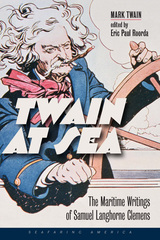
Twain at Sea
The Maritime Writings of Samuel Langhorne Clemens
Mark Twain
University Press of New England, 2018
Samuel Clemens (1835–1910) repeatedly traversed the ocean during his globetrotting life. A keen observer, the man who recast himself as Mark Twain was fascinated by seafaring. This book compiles selections ranging from his first voyage in 1866—San Francisco to Hawaii—to his circumnavigation of the world by steamship 1897. Despite his background as a “brown water” mariner, Twain was out of his element on the ocean. His writings about being at sea (as well as feeling at sea) reflect both a growing familiarity with voyaging and an enduring sense of amazement. Twain’s shipboard observations capture his interest and amusement in the “blue water” mariners he encountered, with their salty subculture and individual quirks. Twain at Sea collects the author’s essays and travelogues on the maritime world in one volume, including excerpts from Roughing It, The Innocents Abroad, A Tramp Abroad, Following the Equator, and other sources.
[more]
READERS
Browse our collection.
PUBLISHERS
See BiblioVault's publisher services.
STUDENT SERVICES
Files for college accessibility offices.
UChicago Accessibility Resources
home | accessibility | search | about | contact us
BiblioVault ® 2001 - 2024
The University of Chicago Press









